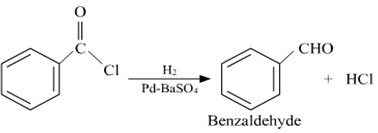(a) Write the products formed when CH3CHO reacts with the following reagents:
(i) HCN
(ii) H2N−OH
(iii) CH3CHO in the presence of dilute NaOH
(b) Give simple chemical tests to distinguish between the following pairs of compounds:
(i) Benzoic acid and Phenol
(ii) Propanal and Propanone
OR
(a) Account for the following:
(i) Cl−CH2COOH is a stronger acid than CH3COOH.
(ii) Carboxylic acids do not give reactions of the carbonyl group.
(b) Write the chemical equations to illustrate the following name reactions:
(i) Rosenmund reduction
(ii) Cannizzaro's reaction
(c) Out of CH3CH2−CO−CH2−CH3 and CH3CH2−CH2−CO−CH3, which gives iodoform test?
(i) Acetaldehyde (CH3CHO) reacts with hydrogen cyanide HCN to give 2-Hydroxypropapanenitrile as product.

(ii) Acetaldehyde (CH3CHO) reacts with Hydroxylamine (NH2OH) to give acetaldoxime as a product.

(iii) The reaction of acetaldehyde with acetaldehyde in the presence of dilute NaOH, this is the kind of Aldol reaction by which obtained 3-hydroxybutanal as a product. Further, proceed reaction when using heat in the reaction, its gives aldol condensation product which is But-2-enal.

(b) Chemical tests to distinguish the following compounds:
(i) Benzoic acid and Phenol : Benzoic acid and phenol can be distinguished by FeCl3 tests. Both reacts with FeCl3 to give different colours. Phenol reacts with FeCl3 to give violet coloured precipitate while benzoic acid gives buff coloured precipitate.
3C6H5OH +FeCl3 ---> (C6H5O)3Fe + 3HCl
phenol violet colour
3C6H5COOH +FeCl3 ---> (C6H5COO)3Fe +3HCl
Benzoic acid buff colour
(ii) Propanal and Propanone : These two are distinguished by the iodoform test.propanal does not give iodoform test when it reacts with I2 in the presence of NaOH while propanone give iodoform test when reacts with I2 in the presence of NaOH.
CH3COCH3 +3NaOI --> CHI3 + CH3COONa +2NaOH
Propane Yellow ppt
CH3CH2OH +NaOI ---> No ppt of CH3I formed
Or
a) (i) Cl-CH2COOH is a stronger acid than CH3COOH :
Substitution of electron withdrawing group on carboxylic acid affect the acidity of the carboxylic acid. Chlorine is a electron withdrawing group and its increase the acidity of carboxylic acids by stabilising the conjugate base due to delocalisation of the negative charge by resonance effects.
Chloroacetic acid ( Cl-CH2COOH) pKa value is equal to 2.7, while pKa value of acetic acid (CH3COOH) is equal to 4.7.
(ii) In carboxylic acid presence of lone pairs of electrons on oxygen which are involves in resonance due to this the electrophilic character of carbon in carboxylic acid decreases. So due to such reason carboxylic acid does not show the characteristic reaction of the carbonyl group.
b)
i)
ii)
C )
Pentan-2-one (CH3-CH2-CH2-CO-CH3) give yellow precipitate of CHI3 with NaOI, that means it gives iodoform test.
CH3-CH2-CH2-CO-CH3 + 3NaOI --> CHI3 + CH3CH2COONa + 2NaOH
Yellow
ppt.
Pentan-3-one (CH3-CH2-CO-CH2-CH3) does not give yellow precipitate with CHI3 with NaOI, so Pentan-3-one does not give iodoform test.
